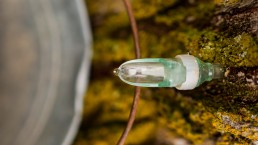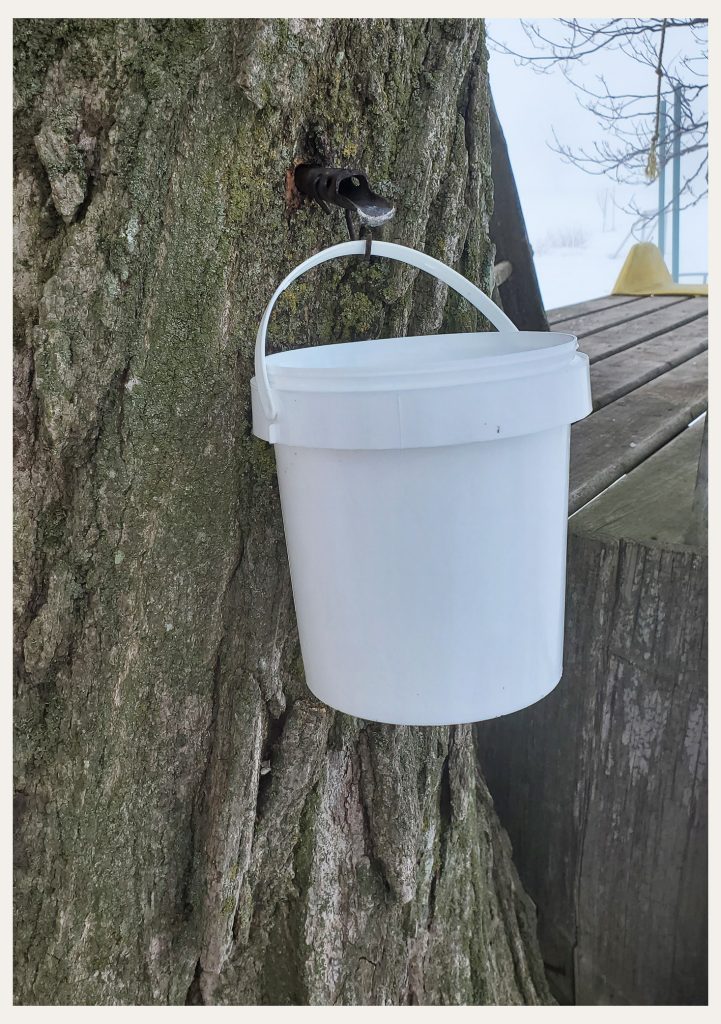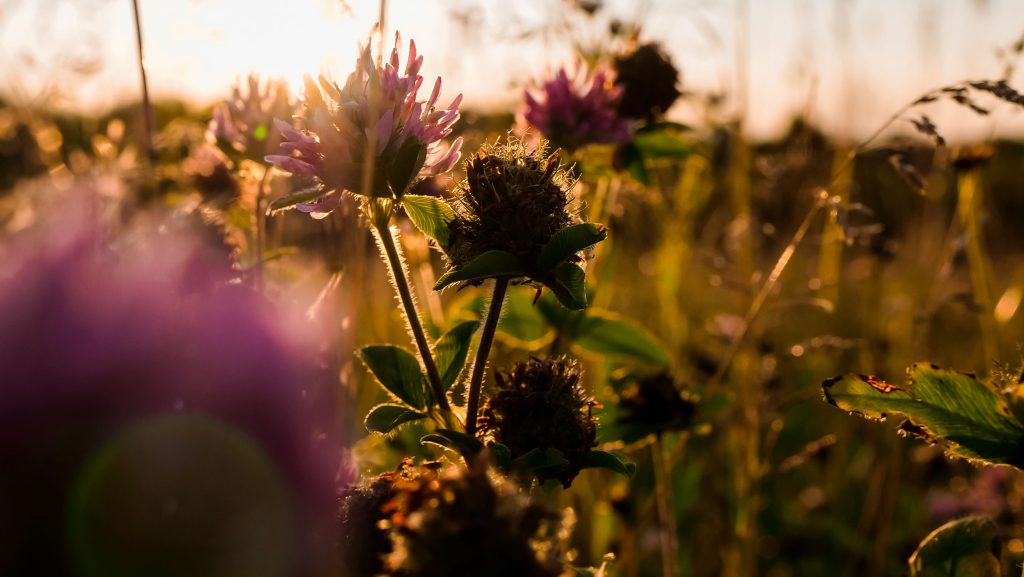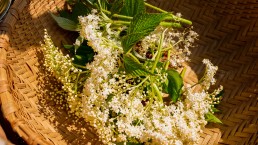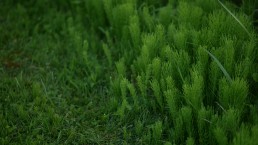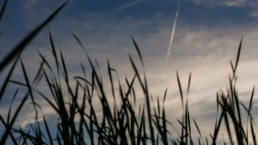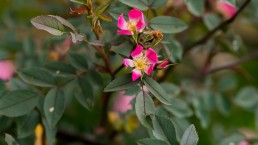Rising of The Sap
Tapping a Sugar Maple with Kids!
While towards the end of winter, it often seems like the cold days are never going to end, there is always this one special activity to look forward to…
One late winter day, one of my sons asked me to ‘tap’ our Maple tree – he wanted to taste the sap. Quickly he remembered that back in the bush, in the abandoned shack, there were dozens of old maple spouts. What can I say; while I use maple syrup in my kitchen weekly, never have I enjoyed the sap straight from the tree.
Finding the Right Tree
Many maple species can be tapped for their sap, but we were out to find the sweetest of the all; the sugar Maple. With our tree bud ID, we quickly set out to find one. It did not take long for the kids to forget about me, running around in the bush, finding several sugar maples on their own. Equipped with a drill, spout and small pail, we started the adventure of tapping our first tree.

You should have seen the joy and amazement in their eyes, as the sap started dripping immediately. Little mouths, wide open right under the spout. Drip, drip, drip. Oh how sweet Maple’s water tasted!*
Close to lunch time we decided to hang the pail and collect the sap. By the time we returned, which was around 3 hours later, our little pail was overflowing! This got us even more curious. How about we collect 2 days worth of sap, and boil it down to make our very own maple syrup – just enough for one pancake breakfast…
Learning Together
One just has to love the innate curiosity kids bring with themselves. This easy and simple activity of identifying a sugar Maple, tapping it, tasting the sap and boiling it down to make syrup, just enough to enjoy it for one special breakfast, filled our weekend with joy, harmony and countless memories made. Not only have my children now experienced the taste of fresh Maple sap, but on a very small scale, they now know the basic process of how to make syrup in our own back yard, with next to no professional equipment, but only what we found in the kitchen. That weekend, we left the car in the garage and appreciated the gifts Mother Nature has offered us. We had each other, surrounded by crisp winter air, the warming rays of father sun and fresh, sweet Maple sap. An activity guided by the sun and the wheel of the year.
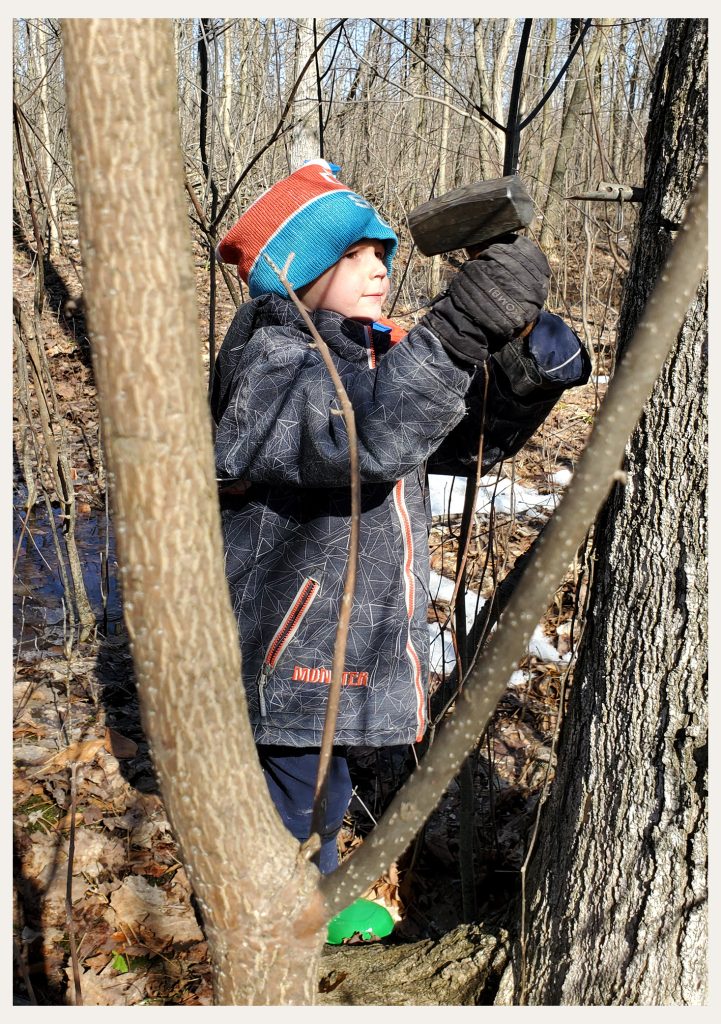
Following the wheel of the year is what brought us as a family closer to nature as well as closer to us, ourselves. While times can be busy and many of families are feeling a ‘disconnect’, it really does not take a lot to find your way back to the natural world and the myriad of gifts that are offered to us.
Reconnect to Mother Nature!
With all that being said, let us help you reconnect with Mother Nature!
At The Lion’s Tooth, we have designed a program to help busy families who feel disconnected from nature and their ancestry. Through 12 digital and in print magazines, with easy and accessible lessons and activities, families can re-connect with nature and learn to use plants like their ancestors did.
It’s time to find your way back to Mother Earth and live by the cycle of the sun. Connect to the wheel of the year and learn foundational knowledge about common wild plants and their many uses.
To learn more and to sign up, visit us at thelionstooth.ca
You can also connect with us on Instagram and Facebook @thelionstooth.ca
*while maple sap has several amazing health benefits, please be aware of the advised cautions when consuming it raw. Please research before drinking.
Featured header photo provided by Serena Mor, and blog photos provided by Evelyn
Herbal Actions: Alteratives
Herbal Actions
What is a “herbal action”?
When we speak about the action(s) of a certain plant, we are referring to one or more effects a plant can have on our body. Often these actions are explained in two or three words; however, herbal actions are so much more than that! Since plants are wonderful complex beings, they also have several actions. Most herbs can compliment their action(s) in combination with another herb, basically showing off their best side with the support of a “good friend”. Sometimes they work great on their own, but most of the times, they excel with a good buddy on their side. Think- Teamwork!
Alteratives
In this blog post, I would like to have a closer look at the ‘alterative’ action of herbs. After studying my resource books and putting together what I have gathered from my mentors, it turned out to be quite difficult in nailing it down to one definition. What can be found in the next few lines, is a summary of my own attempt to define alteratives. While some herbalists may agree with the words below, others may crunch and frown upon this review. As with all studies, especially herbal studies, learn your craft from many different teachers and find what works best for you.
When I think of alteratives, I immediately think of a tonic action. Tonifying herbs usually slowly, but gradually, alter and support the bodies natural actions and functions. Unlike carminatives for instance, which may help you feel better promptly after a heavy meal has left you feeling full and with an aching stomach, tonic herbs like alteratives take more time to show effects. These effects however, keep one in for the long run and can show beneficial changes in several organs and organ systems. Herbalists once referred to alteratives as ‘blood purifiers’. Nowadays however, most herbalists no longer use this term, as only pure blood can keep one alive and if blood would be poisoned or ‘impure’, our bodies would die.
How Alteratives Work
Alteratives gradually restore proper function of the body, which automatically increases overall health and vitality. By helping to disperse toxic buildup in the interstitial fluid, alteratives aid the body to properly remove toxins and therefore, improve the metabolism, supporting proper absorption and delivery of nutrients and insure healthy elimination. As alteratives are masters of proper elimination, they mainly work on the kidneys, liver, lungs, the lymphatic system and skin.
Many alterative herbs are rich in minerals, vitamins and other trace elements and highly nourishing substances. Furthermore, most alteratives are alkalizing to the blood and help neutralize excess acid in the system. Some work by stimulating digestive function and some are immunomodulators. As stimulants, they mildly stimulate and activate the vital organic functions of the liver and gall bladder.
Personally, I have successfully used alteratives for a variety of instances. I am most excited to share how I was able to effectively clear stubborn eczema on my hands. By its special affinity in supporting organs of elimination, alteratives can help to restore sluggish liver functions. As the master detoxifier, the liver has a wide variety of functions and tasks. If these lack, so does proper elimination, and other organs have to take over the job of a comprised liver. Usually, the lungs, skin, kidneys, liver, colon and lymph share the many tasks of elimination. If one organ works at half capacity, another organ has to pick up the slack. In many cases, it can fall onto the skin, which then may break out with rashes or other skin eruptions. Alteratives are best supported with a holistic treatment protocol, which your herbalist can help you design. This could include dietary, physical, emotional and other lifestyle changes.
It is important to note that initially after starting treatment, skin eruptions can worsen. This is because the skin has already been trying to push these ‘stuck wastes’ out, and with the help of alteratives, now get’s a ‘push’ to finish this task. Therefore, before improvement is seen, initial worsening may happen, usually lasting for only a short period of time.
When to Use Alteratives
When in doubt, use alteratives. As most alteratatives are very gentle and work over a longer period of time, they should be the first group of herbs to consider when working with chronic inflammatory and degenerative diseases. These include skin issues, digestion issues, heat and dryness, cysts, arthritis and autoimmune conditions.
Energetics
As for energetics, many alteratives are bitters. Generally, most bitter plants are drying. In traditional Chinese medicine toxins of the blood and toxin-producing infections are considered ‘excess heat’. Since the Liver is associated with heat, too much heat can create extreme imbalance. Many alteratives are cooling liver herbs.
What are Energetics?
In herbalism we often refer to the “energetics” of plants. This can be a very helpful tool, as we get to not only consider the medicinal action of a plant and a certain condition we are trying to treat, but much more than that, we actually learn to work with the entire ecosystem of both plants and humans/animals. The basic energetics I will be referring to are cold/warm/damp/dry. As an example, if your underlying body condition is usually cold and dry, counter this with warm and damp herbs. This being said, I am not speaking of the actual, measurable temperature of a plant or fruit, but the effect this herb has on the body. As an example, think of biting into a piece of ginger or a cayenne pepper. Hot or cold? How about nibbling on chickweed or biting into a watermelon? Hot or cold?
If this interests you, Matthew Wood’s Book “The Practice of Traditional Western Herbalism” is awesome, or try Jim McDonald’s “Actions and Energetics in Western Herbalism” (available online).
Examples of Some Alterative Herbs
- Arctium lappa (Burdock root) is both preventive and medicinal as it supports the detoxification process. Burdock root assists liver supporting toxin elimination through the skin and bowels. As a bitter, Burdock stimulates the secretion of digestive juices, especially bile. Therefore, it helps with digestion and appetite. Burdock is cooling, as it cools the ‘heat’ of rashes. It is extensively used for the treatment of skin conditions that result in dry and scaly patches. Most effective for psoriasis if used over long period of time. Also great for teenagers with problem skin.
- Taraxacum officinale (Dandelion root and leaf) is similar to Burdock root. Dandelion is useful in signs of a hot inflamed liver with stagnation. It improves liver function and aids the natural detoxification process while protecting liver cells from oxidation and damage. The leaves have clear affinity for the gallbladder and, as such, aid in the digestion of fats. Ideal for those with “sour stomachs”. Great as digestive bitter, cooling to the liver. For chronic inflammation of the liver, it aids proper metabolism, supports detoxification and elimination. It also brings relief in gout and rheumatism as well as glandular swelling.
- Berberis aquifolium, Mahonia spp. (Oregon Grape Root) As a mild alterative, Mahonia is great for use with children as well as the elderly. It has a strong affinity for the liver and supports detoxification and elimination. As a bitter, moistening root that supports secretion of bile from the liver, it shows efficiency in bowel movements. In his book, The Practice of Traditional Western Herbalism, Matthew wood writes that, ‘The typical Mahonia patient is thin, dry, and constipated, with rough, scaly, dry skin.’
- Urtica dioica (Nettles) are considered a ‘blood building herb’ (eczema, headaches) as it tonifies organs and boosts the actions of many organ systems with a special affinity for the urinary tract/kidneys. Nettle is used as a spring tonic and general detoxifying remedy, being an excellent source of nutrition for the weak and feeble, recovering from illness or nursing mothers. Nettles are one of the most nourishing tonic herbs and foods we have in Western herbal medicine. Often times, Nettles are used specifically for childhood eczema and beneficial for all varieties of this condition, especially nervous eczema. Nettles can be helpful as a component of treatment for eczema in adults.
- Trifolium pratense (Red clover) Red clover is said to ‘thin the blood’ and has purification properties often benefitting those suffering with eczema, acne and other skin conditions. It is an important remedy for many childhood ailments and may be used safely for any case of eczema. Red clover is considered in cases of edema and hardened, sore lymph nodes, softening stubborn, hard, encysted lymph nodes. For clearing up cysts in the body, as any alterative, red clover needs to be used over a longer period of time. It has a special affinity to glands around the neck, under the ear and towards the back of the neck, as it tends towards single swollen glands. Check out the doctrine of signatures; The flower head resembles a lymph node. Further, Red clover acts on the liver, protects and aids in detoxification.
I hope this post gave you a little insight on Astringents and how they can interact with our body. This topic is covered much more in depth in the herbal course, which is currently developed and coming soon by our group of wonderful herbalists.
Resources:
Besides my own words, this write up features information from the following resources:
- Jim McDonald – Foundational Herbcraft – www.herbcradft.org – collected writings from www.PlantHealkerMagazine.com.
- David Hoffmann – Medicinal Herbalism: The science and practice of herbal medicine. Healing Art Press, Rochester, Vermont 05767. 2003.
- Abrah Arneson – The Herbal Apprentice: Plant Medicine and the Human Being – Green Heart Press. 2014.
- Matthew Wood – The practice of Traditional Western Herbalism – Basic Doctrine, Energetics and Classification – North Atlantic Books, Berkley, California. 2004.
- Rosemary Gladstar – Herbal Recipes for Vibrant Health – Storey Publishing, 2001/2008
Herbal Actions: Diaphoretics
Herbal Actions
What is a “herbal action”?
When we speak about the action(s) of a certain plant, we are referring to one or more effects a plant can have on our body. Often these actions are explained in two or three words; however, herbal actions are so much more than that! Since plants are wonderful complex beings, they also have several actions. Most herbs can compliment their action(s) in combination with another herb, basically showing off their best side with the support of a “good friend”. Sometimes they work great on their own, but most of the times, they excel with a good buddy on their side. Think- Teamwork!
Diaphoretics
The time of the year has come where many of us start to layer up again. Our hands and feet feel constantly cold, and the two pairs of socks we are wearing don’t seem to do anything. Additionally, our hands are freezing and all we wish for is a hot water bottle attached right to our bodies, tied down tightly with a warm woolly shawl. Believe me, I know what I am talking about…
Perhaps you think, this is not me! Despite the cooler temperatures outside, you just can’t seem to escape the heat. Just the thought of a hot water bottle is making you perspirate…
In this blog, let’s talk about diaphoretics and how they are not only helpful to both the extreme cold and the extreme hot of us, but also, how they can:
- Support the skin in its role as organ of elimination
- Stimulate outward circulation
- Relax tightly closed pores
- Stimulate the immune response and support the bodies natural fever response
Diaphoretics and the Skin
If you have a close look at your skin, you can see that the surface of it appears to be like a tiny little mosaic – not completely smooth like glass, but uncountable small sections with hair follicles and pores. Sometimes, the surface can look quite rough, with many small eruptions that can cause a certain area to develop a rash. This could be a heat rash, caused by sweat that is trapped in the skin or any other superficial rash. With any skin eruption, it is important to source out the root cause and treat it as a whole, as often times it can be a sign of insufficiently working organs of elimination. diaphoretics, however, are a great complimentary way of supporting our skin in healing a rash, while addressing the root cause altogether simultaneously.
If a rash is associated with tightly closed pores, we can help opening them up by using a stimulating and relaxant diaphoretic. Using some gentle alteratives in combination with Diaphoretics, is always a good idea.
Fevers and Stimulating the Immune Response
Some of you might be familiar with using diaphoretics during a fever. Starting at the first sign of a cold or flu, start drinking a hot tea with a diaphoretic blend including herbs such as Elderflowers, Linden flowers, Catnip and Peppermint. Let me put some special emphasis on the heat, as only hot liquids can act as diaphoretics. Many cold diaphoretic herbs will act more as a diuretic, which enhance the drainage of tissue fluid and increase urination.
By exciting our sweat glands, our metabolic activity is stimulated which at the same time, is alerting our immune system to ramp up. Through our skin, toxins can be removed, which can indirectly lower a fever.
Not only can it help to ease the signs and symptoms, but it can also help to drive out a fever. A fever is the bodies natural response to dealing with pathogens. It is important to keep a close eye on the temperature, as a out of hand fever can be quite detrimental. In most cases however, our body is doing an excellent job of killing the pathogens all on their own. By using diaphoretics, we can help generate that heat, stimulate circulation and take the heat from the core of the body and bring it to the periphery. While promoting perspiration, it is incredibly important to stay properly hydrated. Drinking lots and lots of hot tea, water and strengthening bone broth are of upmost importance.
Stimulating and Relaxing Diaphoretics
In general, all diaphoretics promote perspiration by opening up the pores of the skin, and even though it might seem we have to pick either of the two, stimulating and relaxing diaphoretics work best when used in conjunction.
- Stimulating diaphoretics act as a circulatory stimulant. By opening up the capillary beds, they help to bring up the heat up to the surface. For individuals with a cold constitution, this will help to circulate some heat to the periphery. For anyone experiencing hot flashes or are generally of a hotter constitution, it helps to bring the core heat that is stuck on the inside to the outer surface. This is why in most warm climate zones, people tend to enjoy their hot and spicy foods!
Examples of stimulating diaphoretics are: Zingiber officinalis (Ginger), Capsicum annuum (Cayenne) or Achillea millefolium (Yarrow).
- Relaxing diaphoretics help to loosen tight, tense tissues. If your pores are closed tightly, the skin is dry and tense and lacks proper hydration in the form of water and oil or if you just can’t get a good sweat, it might a great idea to add relaxing diaphoretics.
Examples of relaxing diaphoretics are: Tilia europea (Linden flowers), Sambucus nigra (Elder flowers) or Nepeta cataria (Catnip).
I hope this post gave you a little insight on diaphoretics and how they can interact with our body. This topic is covered much more in depth in the herbal course, which is currently developed and coming soon by our group of wonderful herbalists.
Resources:
Besides my own words, this write up features information from the following resources:
– Ursel Buehring Praxis- Lehrbuch Heilpflanzenkunde – Grundlagen – Anwendung – Therapie. 4 ueberarbeitete Auflage. Karl F. Haug Verlag in MVS Medizinverlage Stuttgart GmbH & Co. KG’ 70469 Stuttgart, Germany. 2014. (Published in German language)
– Jim McDonald – Foundational Herbcraft – www.herbcradft.org – collected writings from www.PlantHealkerMagazine.com.
– Lisa Ganora – The action formula – PDF – 2015
– David Hoffmann – Medicinal Herbalism: The science and practice of herbal medicine. Healing Art Press, Rochester, Vermont 05767. 2003.
Herbal Actions: Astringents
Herbal Actions
What is a “herbal action”?
When we speak about the action(s) of a certain plant, we are referring to one or more effects a plant can have on our body. Often these actions are explained in two or three words; however, herbal actions are so much more than that! Since plants are wonderful complex beings, they also have several actions. Most herbs can compliment their action(s) in combination with another herb, basically showing off their best side with the support of a “good friend”. Sometimes they work great on their own, but most of the times, they excel with a good buddy on their side. Think- Teamwork!
Astringents
The Astringent feeling is something you probably can all relate with. If you are unsure, taking a bite out of any unripe fruit or vegetable will quickly remind you what it feels like. Rather swiftly, your mouth will dry out completely and leave you with a very puckering sensation. Another great example is that of black tea, especially one that has been steeping for too long. Why not make yourself a cup and consciously experience the sensation of astringent herbs? Take a sip and leave it in your mouth for about a minute or so. Can you feel how it has affected the mucosal lining, how the tissue has tightened and a very mild analgesic feel is overcoming the inside of your mouth? This is astringency.
Tannins
This dryness you experienced is the result of tannins, found in astringent plants. Tannins are a subcategory of phenolic compounds. Back in the day, tanning leather with astringent plants was very common practice. Animal skins were often preserved with Oak bark, Walnut shells and other specific tree barks. Nowadays, leather is mostly tanned with mineral salts and other inorganic substances. However, the term “tannin” comes from its traditional usage for tanning leather.
I always like to find out “why” a certain plant is high in a certain constituent.
Plants high in tannins (often found in the bark, roots and also leaves) protect themselves internally from different kinds of funguses as well as protection from mold; they are helpful for the plant to prevent water, bacteria or other pests to enter. Externally they serve as protection from loss of fluid from the plant itself. Aren’t plants amazing??
How Astringents Work
Traditionally, astringents are used to treat tissue states.
Herbalist David Hoffmann writes that tannins have a lot of benefits, including:
- Reducing irritation on the surface of tissues through a sort of numbing action
- Reducing surface inflammation
- Creating a barrier against infection, which is of great help for wounds and burns
Astringency also dries up extra moisture in the body. This can be helpful for a cold, wet gut or diarrhea.
Where the energetics are mostly plant specific, it can be said that astringents are cool and dry (with exceptions of course). Therefore, astringents are best suited for damp conditions.
Astringents and the Body
So, let’s get into how astringent herbs can be useful for our body.
By tightening the upper layer of the skin, tannins make it hard for germs to enter the body via the skin. In case of a bleeding wound, astringents can constrict blood vessels to help staunch it. In this case, we call the action styptic. Due to the astringent and mildly analgesic actions, astringents work great to soothe a sunburn or other mild burn.
Examples of Some Astringent Herbs
- Achillea millefolium (Yarrow), Arnica montana (Arnica) as well as Quercus spp. (Oak) are all great astringents for the skin.
- Rubus fructicosus (Blackberry) root seems to be well known for its high amounts of tannins and is a strong remedy for both diarrhea and dysentery.
Wonderful herbs for the digestive tract include:
- Rubus fructicosus (Blackberry)
- Filipendulum ulmaria (Meadowsweet)
- Salvia officinalis (Sage)
Astringent herbs are frequently used to address urinary incontinence, bedwetting, and are an important part of urinary tract infection treatments.
Specific herbs for the urinary tract include:
- Equisetum arvense (Horsetail),
- Achiella millefolium (Yarrow)
- Cyanococcus (Blueberry leaf).
If you have experienced pregnancy, chances are you drank lots and lots of Rubus ideaus (Raspberry leaf) tea. This nutritive astringent tonic is great to strengthen the uterus and get it in “top form” for delivery – and back into form, after delivery. Rubus ideaus is a wonderful herb for the reproductive system.
I hope this post gave you a little insight on Astringents and how they can interact with our body. This topic is covered much more in depth in the herbal course, which is currently developed and coming soon by our group of wonderful herbalists.
Resources:
Besides my own words, this write up features information from the following resources:
– Ursel Buehring Praxis- Lehrbuch Heilpflanzenkunde – Grundlagen – Anwendung – Therapie. 4 ueberarbeitete Auflage. Karl F. Haug Verlag in MVS Medizinverlage Stuttgart GmbH & Co. KG’ 70469 Stuttgart, Germany. 2014. (Published in German language)
– Jim McDonald – Foundational Herbcraft – www.herbcradft.org – collected writings from www.PlantHealkerMagazine.com.
– David Hoffmann – Medicinal Herbalism: The science and practice of herbal medicine. Healing Art Press, Rochester, Vermont 05767. 2003.
– Abrah Arneson – The Herbal Apprentice: Plant Medicine and the Human Being – Green Heart Press. 2014.
– Matthew Wood – The practice of Traditional Western Herbalism – Basic Doctrine, Energetics and Classification – North Atlantic Books, Berkley, California. 2004.
– Lisa Ganora – Herbal Constitiuents: Foundations of Phytochemistry – Herbalchem Press, Louisville, Colorado. 2009
Herbal Actions: Bitters
Herbal Actions
What is a “herbal action”?
When we speak about the action(s) of a certain plant, we are referring to one or more effects a plant can have on our body. Often these actions are explained in two or three words; however, herbal actions are so much more than that! Since plants are wonderful complex beings, they also have several actions. Most herbs can compliment their action(s) in combination with another herb, basically showing off their best side with the support of a “good friend”. Sometimes they work great on their own, but most of the times, they excel with a good buddy on their side. Think- Teamwork!
Bitters
In our modern “western” diet, there are only a handful of bitters that have established themselves into restaurants and home kitchens. But then, most of the time, the natural bitter taste of these power foods is reduced by for example sprinkling sugar on a grapefruit or by offering caramelized Brussel sprouts instead of experiencing the real deal. How about a good, bitter coffee? Well, most decide to add a big load of sugar into their dark brew… It almost seems like the naturally occurring bitter taste has become the enemy.
How did we get there? Considering the endless health benefits of bitter plants and foods, why do we try to either mask them or associate them with something bad?
Where our ancestors diet mainly consisted of foraged foods, including lots of bitters, it seems that our modern culture has been taught to like sweets, and dislike bitters. A lot of times when we taste something bitter, we think “Eww! That’s so gross!”. But how about don’t engage in this kind of thinking; how about we go “Wow! That is so POWERFUL!!” Because that is exactly what it is! It is within our power to take away that judgement and re-train our brain. Do you want to join? Let’s try something.
A very wise and experienced herbalist once shared with me how to get my kids to like/ be okay with bitters – lucky for everyone, this technique also works extremely well for grown ups. Yay!! Ready?? Go outside and pick either a dandelion leaf (a mild bitter) or, for a stronger bitter experience, pick some Yarrow or Mugwort. After a nod of gratitude and making sure it does not come from a sprayed lawn or has seen frequent pet-traffic, go ahead and nibble on it. Now try to experience the following:
Phase 1 – Brain response: Our body notices we are chewing on something bitter – Think: WOW!! This has power!
Phase 2 – Contraction: Now it is time to surrender; let your body feel this power and do not fight it or hold the contraction. How does it make you feel?
Phase 3 – Relaxation: After the initial “power-shock”, can you feel how your system is relaxing? Can you feel how your digestive tract is responding; producing a pleasant warming feel in your stomach? Can you feel how your gut-brain connection is not just helping to relax your gut, but also your nervous system?
BITTERS FOR POWER!!
Try this with many different bitter tastes and gradually increase them in your diet. It is also super beneficial to get into the habit of taking bitters just before a meal. But more on that in a little bit…
But, How Bitter is Bitter?
Sometimes you can find a number referring to how bitter a plant is. The number of 1000 for instance describes that 1g of the plant substance can still be experienced as bitter in 1000ml of water.
To get an idea of how bitter some plants are, let me share a few of these bitter numbers:
| Taraxacum officinalis (Dandelion) | 100 |
| Orange Peel | 600 |
| Alchiella millefolium (Yarrow) | 3.000 – 5.000 |
| Artemisia vulgaris (Mugwort) | 10.000 – 20.000 |
| Artemisia absinthium (Wormwood) | 10.000 – 30.000 |
| Gentiana lutea (Gentian) | 10.000 – 30.000 |
A bitter herb like Wormwood tastes so bitter and bile-like, that you cannot simply “wash it down” with a cup of water or something even stronger. Its bitterness is so intense that it can be felt in both your mouth and esophagus for an hour or more afterwards.
How Bitters Work
Bitters can have positive effects on many body systems. In this post I will be focusing on the bitter action on the digestive tract.
As the traditional German saying has it: “Was bitter im Mund, ist dem Magen gesund” – ‘What’s bitter on the tongue is healthy for the stomach’.
Interestingly, bitter taste receptors are not only found in the mouth, but also in the respiratory tract, the liver, the GI-tract, parts of the urogenital tract and other places in the body.
Bitters are intense communicators; when tasted by the tongue, they literally demand attention and provoke a response. The first response happens right away in the mouth as the salivary enzymes get ready for action and salivation increases. Saliva moistens the food and contains enzymes like amylase and lingual lipase. Amylase breaks down starches into sugars for easier absorbed by the body, and lingual lipase kickstarts the break down of fats.
Besides the increase of salivary secretions, messages are sent to the digestive system, signaling the release of the digestive hormone gastrin. Peristalsis, the wavelike motion of the digestive system that stimulates the motility of food along the digestive tract is prompted as well. The digestive tract is encouraged to start properly breaking down food and ensuring optimal absorption of nutrients.
Among Many Other Actions, Bitters:
- Trigger digestive functions
- Stimulate the release of digestive juices
- Increase the flow of bile
- Aid the liver in detoxification work
- Promote intestinal motility
- Are tonifying
- Stimulate appetite
Using Bitters and Preparations
Many herbalists suggest using bitters in form of a tincture. Especially for digestive uses, bitters should really be tasted. A lovely herbalist friend of mine once suggested putting them into a small spray bottle for easier use. This excellent technique makes it really easy and convenient to “quickly” take your bitters.
Otherwise, befriend the powerful bitters and add as many as you can to your regular diet. Start slowly and increase the addition of bitters and reduction of sweetness.
Alternatively, any bitter can also be taken in the form of a tea as gentle decoction. As many bitters also contain aromatic compounds, keep the lid on while decocting and carefully add the accumulated drips on the lid back into your brew. A bitter tea, however, may not be your first choice if you are new to the bitter taste.
Those Who Should Avoid Bitters – Contraindications:
Pregnant women may want to stick to very mild bitters as stronger bitter can potentially cause cramping. Before taking bitters, contact a professional herbalist if you are experiencing heart burn or gastroesophageal reflux disease. They will be able to help you determine if bitters are going to be helpful or possibly worsen the situation. A further contradiction from bitters is if one is suffering from kidney or gallstones. For those with a generally cool/dry constitution, add some warming spices (like ginger or thyme) to counter the generally cooling energetics of bitters.
Examples of Some Bitter Herbs
Lovely bitter herbs to support the digestive tract include;
- Rumex crispus (Yellow dock)
- Gentiana lutea (Gentian)
- Taraxacum officinalis (Dandelion)
- Artemisa vulgaris (Mugwort)
- Matricaria recutita (Chamomile)
I hope this post gave you a little insight on Bitters and how they can interact with our body. This topic is covered much more in depth in the herbal course, which is currently developed and coming soon by our group of wonderful herbalists.
Resources:
Besides my own words, this write up features information from the following resources:
– Ursel Buehring Praxis- Lehrbuch Heilpflanzenkunde – Grundlagen – Anwendung – Therapie. 4 ueberarbeitete Auflage. Karl F. Haug Verlag in MVS Medizinverlage Stuttgart GmbH & Co. KG’ 70469 Stuttgart, Germany. 2014. (Published in German language)
– Jim McDonald – Foundational Herbcraft – www.herbcradft.org – collected writings from www.PlantHealkerMagazine.com.
– David Hoffmann – Medicinal Herbalism: The science and practice of herbal medicine. Healing Art Press, Rochester, Vermont 05767. 2003.
– Lisa Ganora – Understanding Herbal Constituents and Plant Chemistry (2007)
Herbal Actions: Demulcents
What is a “herbal action”?
When we speak about the action(s) of a certain plant, we are referring to one or more effects a plant can have on our body. Often these actions are explained in two or three words; however, herbal actions are so much more than that! Since plants are wonderful complex beings, they also have several actions. Most herbs can compliment their action(s) in combination with another herb, basically showing off their best side with the support of a “good friend”. Sometimes they work great on their own, but most of the times, they excel with a good buddy on their side. Think- Teamwork!
Demulcents
Let’s have a talk about our “Gentle Healers”. Not only are demulcent herbs soothing and gentle, but they also tend to be very nutritive. They are gently supporting and helping us to heal. A group of herbs you simply have to love…
Demulcent herbs are rich in carbohydrate mucilage, which is composed of heteropolysaccharides (various forms of sugars). These posses the ability to bind themselves to water, which will then turn viscous/gel like and stick to the surface of the plant material. Have you ever made yourself a pot of chia pudding? You may have noticed how the dried seeds swell up after a few minutes of being exposed to water (both warm or cold). They can build what seems like a soft cocoon of viscous mucilage around them. A leaf of common mallow will also easily demonstrate this effect – notice how after a few times chewing your saliva turns viscous and gel-like?
Did you know that some plants like to use this feature of the mucilaginous, “slimy cocoon” to spread their seeds? When ingested by animals, the protective coat often helps prevent the eaten seeds from being digested. You can guess what happens next… The animals defecate the coated seeds and give them a little boost with their very own fertilizer. Fascinating!!
Generally Speaking, Demulcents are Indicated in:
- Dry, tight tissues
- Inflammation with dried out mucous secretion
- To cool, coat and soothe
- To stimulate peristalsis in constipation
- As binder in cases of diarrhea
- Soothe stomach and esophageal tissue from acid burn
- Prevent ulceration
- Irritations in the urinary tract
- As lubrication and skin emollient
The energetics of demulcents are fairly straight forward; they are generally moist and tend to be cooling. Due to the polysaccharides, they tend to have a sweet taste. We also have to remember that the energetics of a herbal action are more of a guideline. Considering the individual herb to more properly “classify” its energetics is the right path to go.
Examples of Some Demulcent Plants
Demulcents for the digestive tract:
Althea officinalis (Marshmallow), Plantago scarba (Psyllium husk) or Linium usitatissimum (Flax seeds). Demulcent herbs have to ability to lay a protective coat over mucous membranes and other tissue it comes in contact with. Therefore, demulcents used in the digestive tract have the ideal conditions to show of their best side.
Demulcents for the respiratory tract:
Verbascum Thapsus (Mullein), Tussilago farfara (Coltsfoot), Althea officinalis (Marshmallow). By providing a protective coat over the inflamed airways, demulcents soothe and function as analgesics, anti-inflammatory and as protective layer over the mucous membranes.
Emollient herbs for the skin:
Linium usitatissimum (Flax seeds), Symphytum officinale (Comfrey), Althea officinalis (Marshmallow). Many herbalists refer to mucilage internally used as demulcents and topically used as emollients. Emollients help provide flexibility to dry, irritated and inflamed skin conditions. Often times, applying the herb in form of a poultice seems to work very effectively.
Demulcents for irritation in the urinary tract:
Elymus repens (Couch grass), Zea mays (Conrsilk) and Althea officinalis (Marshmallow) are all excellent demulcents for any irritation, burning, and other irritable sensations in the urinary tract and have been used very successfully over many generations. Diuretics working on solid material work best with the assistance of lubricating demulcents.
Preparing a Cup of Tea
Traditionally, most demulcents are prepared via cold infusions. The reason behind this is that we are focusing to mainly extract the mucilaginous polysaccharides – our gentle healers… If you are preparing milder or more complex demulcents, you might be looking at a hot infusion.
A very effective way is to infuse 1-2 tbsp of dried herb into 1 liter of cold water. Let this sit overnight. In the morning, you have a wonderful soothing infusion. You could also just let it sit for a few hours, but the longer the herb infuses, the more viscous the tea will get.
Especially on hot and dry days, you might want to consider adding some Althea officinalis root to your water; it will help you stay better hydrated and tastes super yummy!
I hope this post gave you a little insight on demulcent herbs and how they can interact with our body. This topic is covered much more in depth in the herbal course, which is currently developed and coming soon by our group of wonderful herbalists.

Comfrey Leaf (Symphytum officinale)
Resources:
Besides my own words and oral teachings from many wonderful herbalists, this write up features’ information from the following resources:
Ursel Buehring Praxis- Lehrbuch Heilpflanzenkunde – Grundlagen – Anwendung – Therapie. 4 ueberarbeitete Auflage. Karl F. Haug Verlag in MVS Medizinverlage Stuttgart GmbH & Co. KG’ 70469 Stuttgart, Germany. 2014. (Published in German language)
Jim McDonald – Foundational Herbcraft – www.herbcradft.org – collected writings from www.PlantHealkerMagazine.com.
David Hoffmann – Medicinal Herbalism: The science and practice of herbal medicine. Healing Art Press, Rochester, Vermont 05767. 2003.
Abrah Arneson – The Herbal Apprentice: Plant Medicine and the Human Being – Green Heart Press. 2014.
Matthew Wood – The practice of Traditional Western Herbalism – Basic Doctrine, Energetics and Classification – North Atlantic Books, Berkley, California. 2004.
Rosemary Gladstar –Rosemary Gladstar’s Herbal Recipes For Vibrant Health: 175 Teas,…- Storey Publishing, LLC – September 3, 2008
Talking About: Adaptogens
Adaptogens
What Are Adaptogens?
Often times, we have to just listen very closely to a client’s story and they will actually tell us the answer themselves. The same concept applies to the term “adaptogen” – listen closely “adaptogen” – “to adapt” – “adapting”… Looking at it from a broad view, this is what this group of herbs does. Adaptogens help us adapt to both environmental and psychological stresses.
It is said that 75% – 90% of all doctor visits in North America may have a stress-related component. Clearly, our bodies are sending us signals – these signals can include loss of interest, poor memory or feelings of worry and fear. Symptoms can also include (but are obviously not limited to) manifestations which we may not even relate to stress; like feelings of tension, fatigue or digestive issues.
If our body is unable to naturally recover from stress, there are two essential ways to support it in its ability to cope and recover. The first one is to address the initial stressors and find ways to limit the root cause. The second is to introduce the “super-heroes” of the herbal world – Adaptogens.
Any reputable herbalist will support clients in both ways. They will help find a herb that suits the individuals needs best, usually within a personalized formula, but will also share effective techniques to help cope with stress and exhaustions.
In summary, adaptogens:
- Increase resilience
- Increase physical performance
- Increase coordination, cognitive performance, memory and concentration
- Improve mental and physical activity and stamina
- Have a tonifying and immunomodulating effect
Getting a Hand on the Root Cause
Yes, adaptogens are amazing. They are the number one group of herbs to help us become more resilient to stressful situations and support our organism when suffering from stress related fatigue and other symptoms. However, when working with adaptogens, we have to keep in mind that they can certainly help us “adapt”, but also, adaptogens will only effectively work long term if we also address the root cause that has brought one to this state of physical and emotional exhaustion. Biological stressors, chemical stressors, consumable stressors, environmental stressors, psychological, physical, as well as spiritual stressors all have to be addressed. Trying to fix symptoms instead of addressing the root problem can be dangerous.
Apoptogenic Herbs
If you think adaptogens are what’s needed in your life, be sure to find the right one for YOU. Adaptogen isn’t always adaptogen. For example, if one lit their candle on both ends and as a result crash and are burned out, a relaxing adaptogen like Ashwagandha might not be the first choice. We might want to work with a more stimulating herb like Rhodiola. But even then, if the client’s constitution tends to be rather dry, Rhodiola might, in the long run, irritate even more. Therefore, in order to receive the best long lasting results, it is always advised to contact a professional herbalist to help find which adaptogen might work best.
Examples of Some Apoptogenic Herbs
Rhodiola rosea (Rodiola) – Stimulating
Can help with brain fog, increase concentration, memory as well as mental capacity. Has also been recognized to help with depression, particularly the “winter blues” (SAD).
Eleutherococcus senticosus (Eleuthero, Siberian Ginseng) – Stimulating
Eleuthero is helpful for those who can’t get out of bed, even after a full night of sleep. For those dragging through the day, foggy brain… Eleuthero supports a depleted immune system by promoting natural detoxification processes in the liver.
Withania somnifera (Ashwagandha) – Strengthening without stimulating, calming
Particularly helpful for individuals who seem depleted and “worn out”. Has been used to heighten intellectual capabilities and longevity, for those with insomnia, wired/cloudy thinking and fatigue. Ashwagandha has improved long and short-term memory in people with mild cognitive impairments and has successfully been used those with OCD and ADHD.
Schisandra chinensis (Schisandra) – calming
Schisandra creates a calm feeling while increasing focus and gently boosting physical energy levels. It has hepatoprotective properties, meaning that it is liver protecting and blood purifying. Schizandra is thought to enhance the endocrine system and nonspecific immune system function, which is the one most affected by stress.
Ocimum sanctum (Tulsi/ Holy basil) – relaxing
This calming and relaxing adaptogen has been successfully used to help manage stress, poor memory, anxiety and be of support when one feels irritable. Tulsi clears the Aura, gives the power of awareness and harmonizes. Tulsi may also be beneficial in cognitive disorders such as Alzheimer’s disease and dementia.
I hope this post gave you a little insight on adaptogenic herbs and how they can interact with our body. This topic is covered much more in depth in the herbal course, which is currently developed and coming soon by our group of wonderful herbalists.
Resources:
Besides my own words and oral teachings from many wonderful herbalists, this write up features’ information from the following resources:
Ursel Buehring Praxis- Lehrbuch Heilpflanzenkunde – Grundlagen – Anwendung – Therapie. 4 ueberarbeitete Auflage. Karl F. Haug Verlag in MVS Medizinverlage Stuttgart GmbH & Co. KG’ 70469 Stuttgart, Germany. 2014. (Published in German language)
Jim McDonald – Foundational Herbcraft – www.herbcradft.org – collected writings from www.PlantHealkerMagazine.com.
Abrah Arneson – The Herbal Apprentice: Plant Medicine and the Human Being – Green Heart Press. 2014.
Paula Grainger – Adaptogens, Harness the power of superherbs to reduce stress & restore calm – Octopus Publishing Group Ltd. 2018
Adriana Ayales – ADAPTOGENS, Herbs for Longevity and Everyday Wellness – Sterling Publishing Co., Inc., New York. 2019
https://www.webmd.com/balance/stress-management/stress-and-the-body
Herbal Actions: Aromatics
Herbal Actions
What is a “herbal action”?
When we speak about the action(s) of a certain plant, we are referring to one or more effects a plant can have on our body. Often these actions are explained in two or three words; however, herbal actions are so much more than that! Since plants are wonderful complex beings, they also have several actions. Most herbs can compliment their action(s) in combination with another herb, basically showing off their best side with the support of a “good friend”. Sometimes they work great on their own, but most of the times, they excel with a good buddy on their side. Think- Teamwork!
Aromatics
Imagine walking through your garden, on your favorite trail, or through the quiet woods. Try to picture this beautiful abundance of growth using your senses. Can you see all the different colors, hear the leaves dancing in the light breeze, feel their softness or even their sharp thorns on your skin? Can you smell the plant? No? Try crushing a leaf… How about now? Can you give it a little taste test? Mild? Bitter? Pungent maybe?
If you have been learning from and with our wonderful plant friends, chances are, you have come across the term/action, “aromatic”. Now let’s get back to our imaginary herb walk from just moments ago. It was right there were you have come across a “sense-able”, or “foundational” (as Herbalist Jim McDonald calls it) action of an herb. An action you can immediately experience using your senses.
When talking about aromatic herbs, we refer to herbs one can easily smell by releasing their oils (referred to as volatile oils or essential oils) from their special secretory structures, such as oil cells, epidermal hairs or resin ducts. Most of the time, this release of oils happens, when the leaves or other plant parts have been crushed.
Did you ever ask yourself why a plant even has all these essential oils and/ or amazing actions? They actually have a variety of natural functions within themselves and act for example as growth regulators, protection from heat or cold or serve, for interplant communication or to attract pollinators.
Before giving you a little glimpse on how aromatic herbs can support our body, please let me clarify that I am writing about aromatics and the action of essential oils within the whole plant, and not the distilled, isolated essential oils (EO) you can buy in little brown bottles. Due to the isolated EO’s high potency, they act very different on the body and should be only used with care and the support of a trained aromatherapist.
Examples of some Aromatic Herbs
Lovely herbs for the respiratory system include Angelica archangelica (Angelica) or Thymus vulgaris (Thyme). With both of them being expectorant, anti-microbial and anti-spasmodic, the volatile oils in the plant help liquify the mucous in the bronchi and transport it upwards via a productive cough.
Lavendula (Lavender) is a wonderful relaxing nervine. Coffee spp. (Coffee- anyone?) on the other hand, is a fabulous stimulating nervine (please note, coffee will only excel if used in moderate doses and if you rule the coffee, not the coffee rules you…) – you got it, both aromatics can be used to address the nervous system.
Often aromatics are referred to as carminatives. I personally see the term carminative as a sub-category to aromatics, specifically in regards to the digestive system. Aromatics/ carminatives are of great help when, for example, fermentation in the stomach becomes a problem. My favorite herbs for the digestive tract include Zingiber officinale (Ginger), Foeniculum vulgare (Fennel) or Matriacria recutita (German Chamomile)
I hope this post gave you a little insight on aromatic herbs and how they can interact with our body. This topic is covered much more in depth in the herbal course, which is currently developed and coming soon by our group of wonderful herbalists.
Resources:
Besides my own words, this write up features information from the following resources:
– Ursel Buehring Praxis- Lehrbuch Heilpflanzenkunde – Grundlagen – Anwendung – Therapie. 4 ueberarbeitete Auflage. Karl F. Haug Verlag in MVS Medizinverlage Stuttgart GmbH & Co. KG’ 70469 Stuttgart, Germany. 2014. (Published in German language) Jim McDonald – Foundational Herbcraft – www.herbcradft.org – collected writings from www.PlantHealkerMagazine.com.
– David Hoffmann – Medicinal Herbalism: The science and practice of herbal medicine. Healing Art Press, Rochester, Vermont 05767. 2003.
– Abrah Arneson – The Herbal Apprentice: Plant Medicine and the Human Being – Green Heart Press. 2014.
– Matthew Wood – The practice of Traditional Western Herbalism – Basic Doctrine, Energetics and Classification – North Atlantic Books, Berkley, California. 2004

